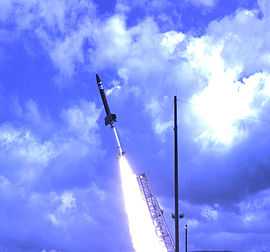Terrier Oriole
 Terrier Oriole at launch | |
| Function | Sounding rocket |
|---|---|
| Manufacturer | Astrotech Space Operations |
| Country of origin | |
| Size | |
| Height | 8.2 metres (324 in) |
| Diameter | 0.56 metres (22 in) |
| Stages | 2 |
| Capacity | |
| Payload to 340 kilometres (210 mi) |
360 kilograms (800 lb) |
| Associated rockets | |
| Family | Terrier |
| Launch history | |
| Status | Operational |
| Launch sites | Wallops Island, Barking Sands |
| Total launches | 10 |
| First flight | July 7, 2000 |
| Last flight | September 1, 2011 |
| First Stage - Terrier Mk 12 | |
| Length | 3.9 metres (155 in) |
| Diameter | 0.46 metres (18 in) |
| Gross mass | 1,001 kilograms (2,207 lb) |
| Engines | 1 |
| Thrust | 258 kilonewtons (58,000 lbf) |
| Fuel | solid |
| Second Stage - Oriole | |
| Length | 3.9 metres (155 in) |
| Diameter | 0.56 metres (22 in) |
| Gross mass | 1,000 kilograms (2,200 lb) |
| Engines | 1 |
| Thrust | |
| Fuel | solid |
Terrier Oriole is an unguided two-stage rocket system which is primarily used by the Goddard Space Flight Center out of the Wallops Flight Facility as a sounding rocket. The system uses a Terrier first-stage booster attached to an Oriole second-stage rocket.[1] The system can carry payloads between 800 to 1,500 pounds (360 to 680 kg) up to an altitude of 320 kilometres (200 mi).[2] It is also used to test ballistic missile defense systems, under the name ARAV-B.
Technical details
The Terrier motor is 18 inches (460 mm) in diameter and 155 inches (3,900 mm) long, and it normally uses two "spin motors", both to reduce dispersion and to serve as drag plates. It uses four equally spaced fins which are 4.8 square feet (0.45 m2) and canted in such a way as to provide two revolutions per second at Terrier burnout. The weight of the Terrier booster system is 2,207 pounds (1,001 kg).[2]
The Oriole motor is 22 inches (560 mm) in diameter and 155 inches (3,900 mm) long. There is a 14 inches (360 mm) interstage adapter between the Terrier and Oriole systems, which allows for drag separation following Terrier burnout. The Oriole stage uses four fins in a cruciform configuration, which are canted in order to provide a spin rate of four revolutions per second upon Oriole burnout.[2]
Standard hardware includes a nose cone and capacitive discharge ignition system. Separation systems are available for use in order to separate the payload from the motor during ascent. An Ogive nose cone is also available to users, when required.[2]
Terrier-Oriole is used to test ballistic missile defense systems, under the name Aegis Readiness Assessment Vehicle-B (ARAV-B).[3] It is much cheaper than other ballistic missile targets.[3]
See also
- Terrier Malemute
- Terrier-Orion
References
- ↑ Dunbar, Brian (March 3, 2012). Wilson, Jim, ed. "NASA's Terrier Oriole Rocket". NASA/GSFC. Retrieved March 16, 2012.
- ↑ 2.0 2.1 2.2 2.3 "Terrier Oriole information brochure" (PDF). NASA.
- ↑ 3.0 3.1 Naval Surface Warfare Center, Port Hueneme Division Public Affairs (April–June 2011). "Ballistic Missile Tracking Exercise Using ARAV-B". CHIPS.